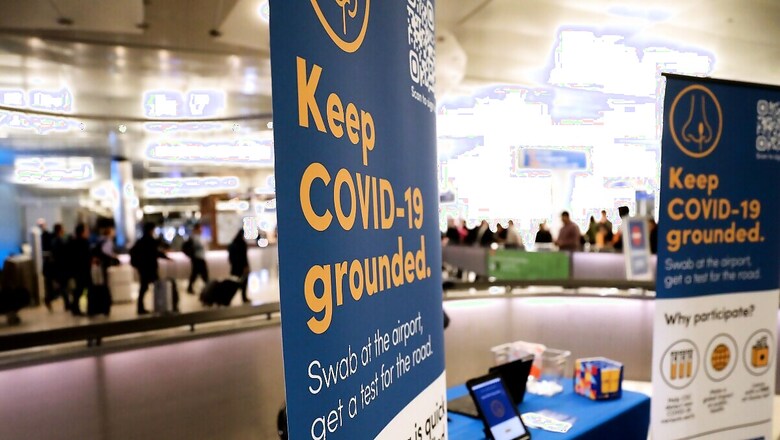JN.1 Covid Variant Symptoms Could Be More Noticeable Than Common Cold; It's a Vicious Cycle: Experts

views
The cases of Covid-19 infections are expected to rise until the population develops immunity to the new JN.1 variant, experts told News18.
While the intensity of JN.1 remains unclear, experts suggest that its symptoms may be somewhat more pronounced than those of the common cold, resembling influenza with signs such as fatigue, severe body ache, and a sore throat. Although younger individuals may not be significantly affected, older adults should enhance their prevention measures as it could pose a risk to those with pre-existing health conditions.
A recently discovered sub-variant, named JN.1, of the Covid-19 virus has been detected in a woman in Kerala, prompting concerns and highlighting the necessity for ongoing vigilance in the battle against the viral disease. On December 16, the Union Health Ministry officially verified the presence of the JN.1 sub-variant of Covid-19 in a patient from Kerala, marking the first reported case in India.
Lineage JN.1 was first found in Luxembourg and as per the latest numbers, it has been spotted in more than 38 countries. JN.1 carries an additional spike mutation, L455S, and this mutation is suspected to have the potential to escape immunity.
Dr Rajeev Jayadevan, former president of the Kochi wing of the Indian Medical Association (IMA), told News18 that the latest surge was “expected” as it has been almost seven months since the last spike.
“As we know, Covid-19 is a cyclical disease, it will keep coming back. It was in April this year when we last saw a spike, as per the INSACOG database, which was caused by XBB sublineages.”
In the rest of the world – especially the wealthy nations, where genomic sequencing and testing are more commonly done – hospitals are seeing an increase in cases of Covid-19.
JN.1 has been the fastest-rising sub-lineage in the past month. “In the US, end of October, only 1 out of 1000 Covid cases were JN.1 and now it is 1 in 5 cases,” Jayadevan said.
Dr Anurag Agrawal, Dean of Biosciences and Health Research at Ashoka University, explained the vicious cycle of Covid-19 infection and why we keep witnessing periodical jumps in cases of infection.
“Immunity in the population declines and the virus develops mutations to escape antibodies… Infections occur and immunity goes up again to new variants and infections come down… Hence, periodically we see increases,” he explained.
According to Dr Vishal Rao, Bengaluru-based head and neck oncologist, and part of the Covid Genomic Surveillance Committee, Government of Karnataka: “The severity of JN.1 is still unclear.” However, he said it is likely to be mild. “Still, it is essential to stay vigilant and follow best practices to prevent the spread of Covid-19,” he advised.
Dr Saumitra Das, co-chair of INSACOG’s advisory board, told News18 that a recurring pattern has been observed, with every new wave emerging in December, spanning from the first wave to the Delta wave and now the Omicron wave.
During the Christmas and holiday season, there is a customary increase in the movement of international travellers. This period marks an annual routine when pathogens can cross borders, underscoring the importance of airport screening.
Professor Das, a microbiologist at the Indian Institute of Science, emphasised the necessity for the government to “enhance surveillance at airports and address the Covid-19 testing system once again.”
Especially during the holiday, Jayadevan advised that India needs to be on “alert” as the country is very well connected with the rest of the world along with heavy inter-state travel.
Government sources told News18 that JN.1 is one among 223 sub-variants that have surfaced so far. Officials maintained there is no cause for alarm and that vaccines should work on this sub-variant too.
Hints About Characteristics of JN.1
“The growth of JN.1 tells us a couple of things about its character,” Jayadevan said.
“One, it can infect people who were immunised or have previous infection or both. Secondly, its ability to spread is also high which overcomes immune response and spreads from one person to another. Hence it’s a superior variant.”
Jayadevan further explained: “As JN.1 comes from BA2.86, we know that BA 2.86 was a vastly different variant which was never seen before… It showed up around the latter half of this year and circulated quietly in many countries. Then came JN.1 which is one spike mutation away from BA.2.86 with a difference of L455S.”
Regardless of these changes, it can circulate widely and infect people despite vaccines, boosting and natural infection.
“Right now, we do not have any indication of severity… Most likely, the younger people will witness influenza-like conditions and not just a common cold with symptoms such as severe body aches, fatigue, unable to work and sore cough.”
“However, older individuals may feel de-saturation and de-stability of their other comorbid conditions. Hence, they should be more careful to not pick up infections this season and upgrade their prevention strategy.”
Closely Monitor the Rate of Hospitalisation
Rao from Bengaluru said that the virus has been constantly evolving and this outbreak has not come as a surprise. “Early on, it was the XBB strain, then the BA2.86 and now it’s the JN.1 but what’s concerning is this virus won’t stop its evolution.”
He said “globally the worry has been whether it will evolve to a deadlier variant like Delta which could penetrate lungs”.
“For Omicron, we were particularly lucky as the variant lacked TRAMPess pathway which did not let it habitats lungs. And of course, vaccines gave us partial immunity.”
Experts said that with winter setting in and also many other viruses around that cause flu-like symptoms, it is imperative to exercise caution. Additionally, they said that as we are entering into the festive holiday season, socialisation would increase and hence, exposure.
“What stands to be closely monitored now is whether the increased socialisation leads to an increase in hospitalisation or illness,” Rao said. “We are far from a new upgraded version of the vaccine, and the virus seems to move much faster in its evolution. At this juncture, we are back to the old rules of this game with the most important emphasis on indoor ventilation, early symptoms detection and genomic surveillance,” Rao added.














Comments
0 comment